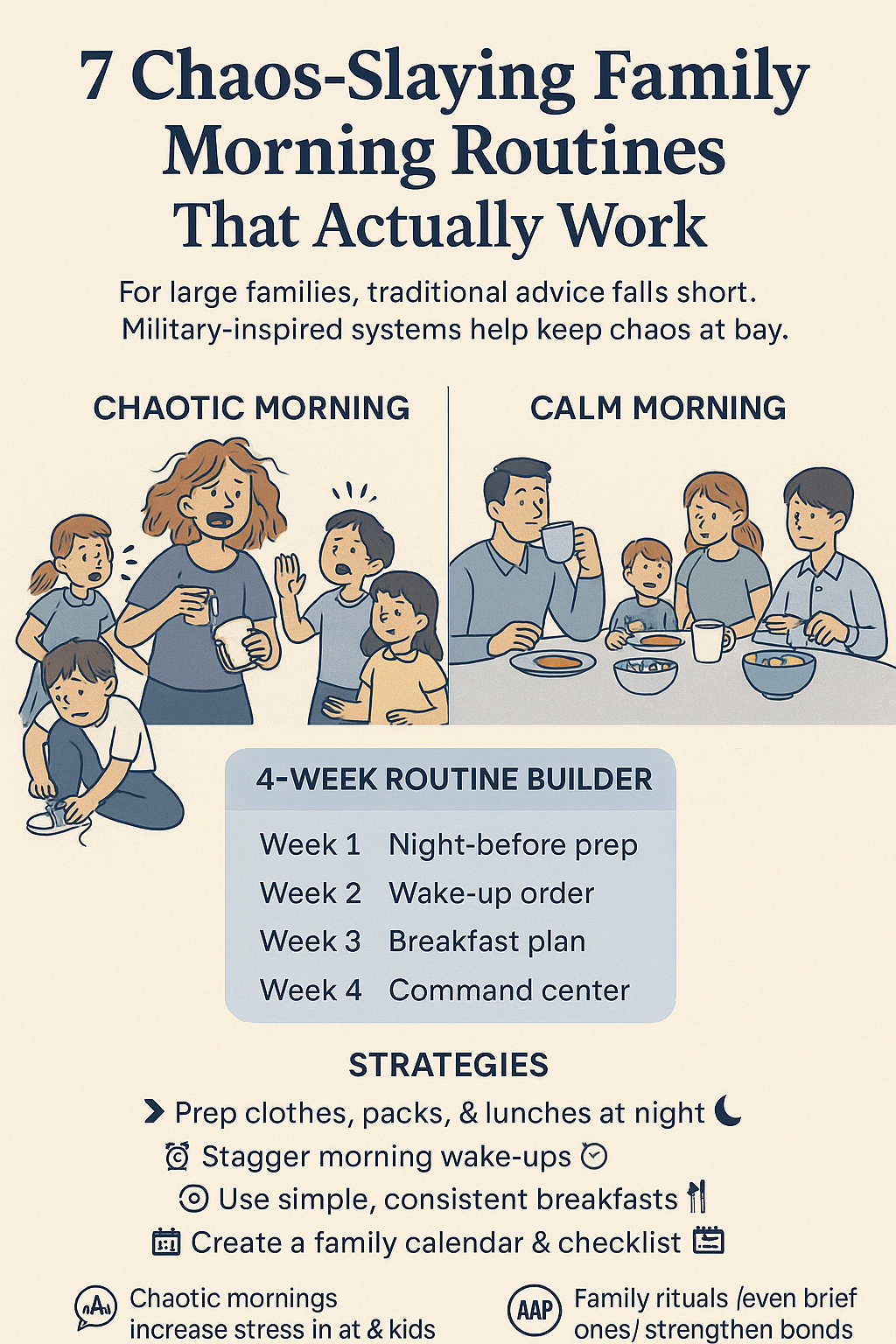Family Morning Routines: 7 Shocking Strategies ⚡

The alarm goes off at 0530 hours. But instead of the organized chaos I’d experienced in the military, my house erupts into something that resembles a battlefield where everyone forgot their mission briefing—and possibly their pants. 🤦♂️
Sound familiar?
If you’re drowning in the daily struggle of getting multiple kids ready, fed, and out the door without losing your sanity (or your coffee), you’re definitely not alone. After twenty years of marriage and raising six kids, I’ve learned that successful family morning routines aren’t about perfection—they’re about creating systems that actually work for real families dealing with real chaos.
The truth is, most parenting advice about morning routine tips comes from people who’ve never tried to coordinate five girls and one boy through breakfast, backpack searches, and bathroom breaks while simultaneously preventing World War III over who gets the last Pop-Tart. But when you’re dealing with the reality of large family life, you need family organization strategies that can handle the beautiful mess that comes with it.
Why Traditional Morning Advice Falls Flat for Big Families 💥
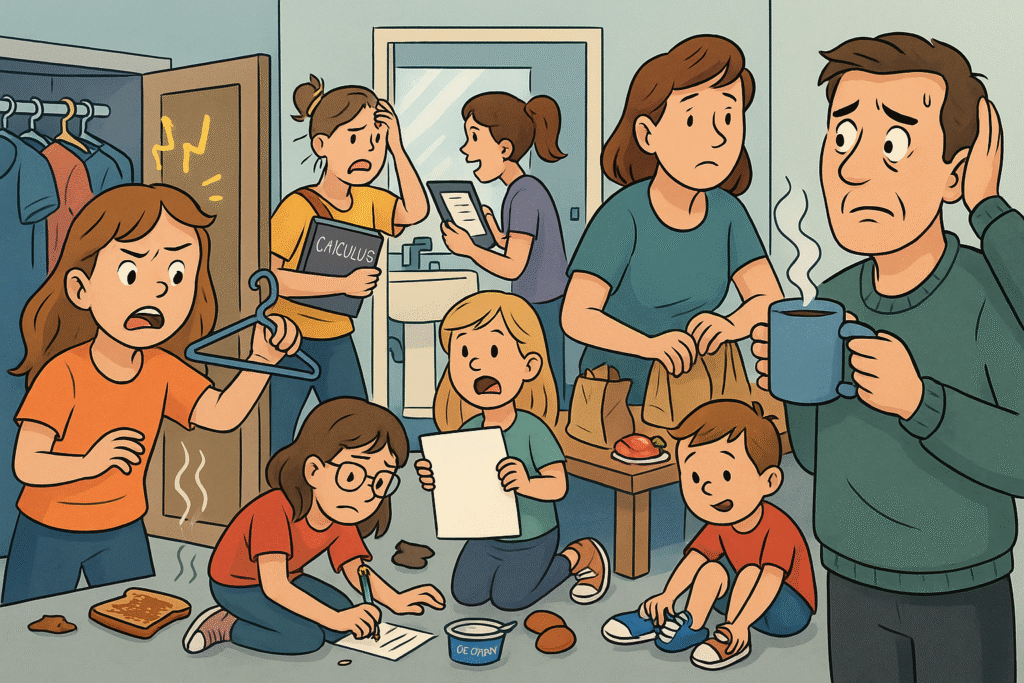
Let me paint you a picture of what mornings used to look like in our house before we figured things out. Picture this: complete pandemonium with a side of burnt toast.
Natalie would be frantically searching for her calculus homework while simultaneously having an existential crisis about whether she actually understood derivatives. Allyson would be practicing her presentation in the bathroom mirror (the acoustics are apparently superior there). Kaelyn would announce she had “literally nothing to wear” despite a closet that could stock a small boutique.
Meanwhile, Melody would be conducting a full-scale investigation to find her “lucky pencil” for her math test, and Gabrielle would casually drop the bombshell that she needed poster board for a project due that day. Because obviously, the best time to remember major school assignments is when you have exactly seventeen minutes before departure.
And six-year-old Brayden? He’d be trying to put his shoes on the wrong feet while earnestly asking if ice cream counted as a breakfast food. (The answer is still no, buddy, no matter how convincingly you argue that it contains milk.)
My wife Jackie, bless her patient heart, would be attempting to pack six lunches while simultaneously helping with homework questions and reminding everyone about their after-school activities. I’d be standing there with my coffee, wondering how the military taught me to coordinate complex international operations but somehow failed to prepare me for getting kids ready for school. 😅
The problem with most morning routine tips you find online is they’re designed for families with one or two kids—you know, those mythical families where everyone cooperates and nobody has meltdowns over mismatched socks. When you’re managing six different personalities, schedules, and urgent breakfast demands, those cute little charts and simple systems fall apart faster than a house of cards in a Category 5 hurricane.
Research from the Kids Mental Health Foundation shows that routines help children feel safe and build independence, decreasing stress and helping kids handle emotions. But here’s what they don’t tell you: the solution isn’t eliminating chaos—it’s learning to choreograph it like a well-rehearsed dance number. Think “Hamilton” but with more spilled orange juice and missing backpacks.
The Military Mindset: Adapting Mission Planning for Family Life 🎯
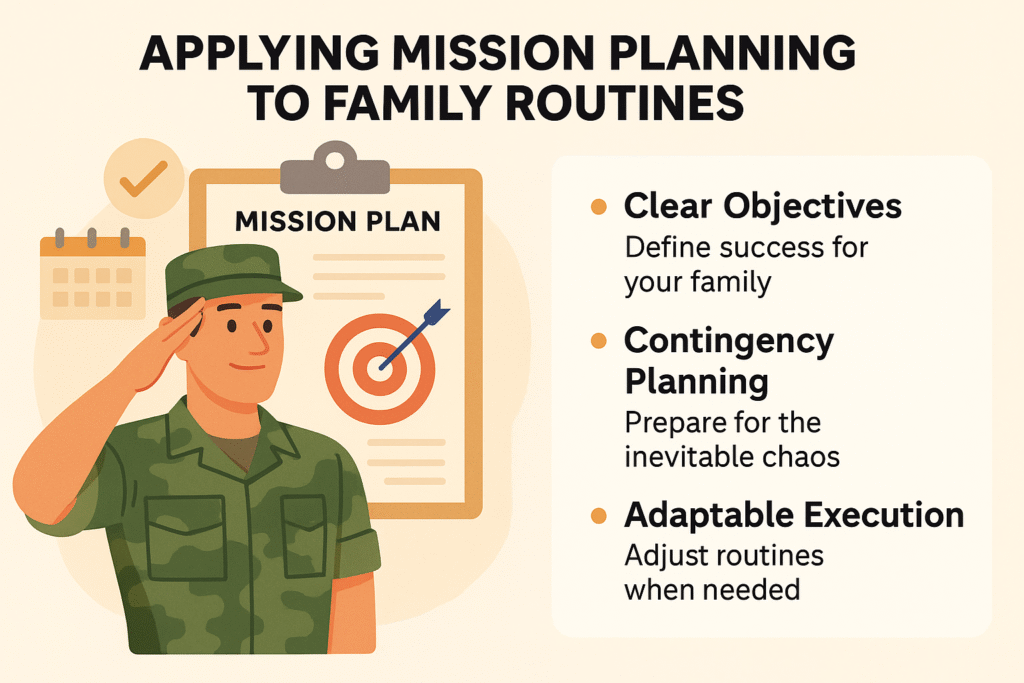
During my time in the Air Force, I learned that successful operations require three things: clear objectives, contingency planning, and adaptable execution. Turns out, these same principles work brilliantly for family organization when you apply them correctly—though thankfully, nobody has to salute at breakfast.
The key difference is understanding that your family isn’t a military unit (thank goodness), but you can still use structured thinking to create healthy family routines that actually stick. Plus, in the military, if someone doesn’t follow orders, they face disciplinary action. With kids, if they don’t follow the routine, they give you those adorable puppy dog eyes and suddenly you’re making pancakes at 6:47 AM.
Different battlefield, same need for strategy.
Clear Objectives: Define Success for Your Family Morning Routines
In the military, every mission starts with a clear objective. For family morning routines, your objective might be: “Everyone fed, dressed, and out the door with necessary items by 7:30 AM, with minimal stress and maximum connection—and preferably without anyone crying.”
Notice I didn’t say “perfectly organized” or “Instagram-worthy.” Real family life doesn’t look like social media, and that’s perfectly okay. Our morning victories include things like “everyone wore matching shoes” and “nobody forgot pants.” Set your standards accordingly.
Contingency Planning: Prepare for the Inevitable Chaos
Military operations always include contingency plans because things go wrong. In family morning routines, Brayden will spill orange juice on his shirt five minutes before leaving. Melody will remember her science project exists approximately thirty seconds before we need to walk out the door. Gabrielle will have a complete meltdown about her hair resembling a “deranged porcupine” (her words, not mine).
This isn’t failure—it’s Tuesday. And also Wednesday through Friday.
The families who thrive with morning routine tips are the ones who plan for these moments instead of being blindsided by them every single day like some sort of groundhog day nightmare.
Strategy #1: The Night Before Foundation 🌙
The single most effective time saving tips I can share comes from shifting 70% of your morning prep to the night before. This isn’t rocket science, but it requires consistent execution—and possibly bribing your kids with extra screen time.
Here’s our battle-tested evening routine that supports our family morning routines:
Clothes Selection: Each kid picks out their complete outfit, including underwear, socks, and shoes. Everything goes on their dresser or chair. No exceptions, no morning negotiations, no “but I changed my mind about the unicorn shirt.” The fashion democracy is closed after 8 PM.
Backpack Station: All homework, permission slips, and supplies go in backpacks immediately after homework time. Backpacks live by the front door, not scattered throughout the house like some sort of educational treasure hunt.
Lunch Prep: Non-perishable items get packed the night before. Sandwiches can be made and refrigerated (they taste the same, I promise). We use an assembly line approach when possible because efficiency is beautiful.
Bathroom Essentials: Toothbrushes, hair ties, and any necessary medications get organized the night before. This prevents the morning scramble where everyone suddenly needs seventeen different hair accessories that have mysteriously vanished into the Bermuda Triangle of our house.
Research from the University of Rochester Medical Center indicates that children who have consistent bedtime routines sleep better and have easier mornings. When kids aren’t rushing to make forty-seven decisions first thing in the morning, everyone’s stress levels decrease significantly—including yours.
This preparation time investment of 20-30 minutes each evening saves us at least an hour every morning and eliminates about 90% of the typical morning arguments. The remaining 10% are usually about whether cereal counts as a balanced breakfast (it does if you add fruit, fight me).
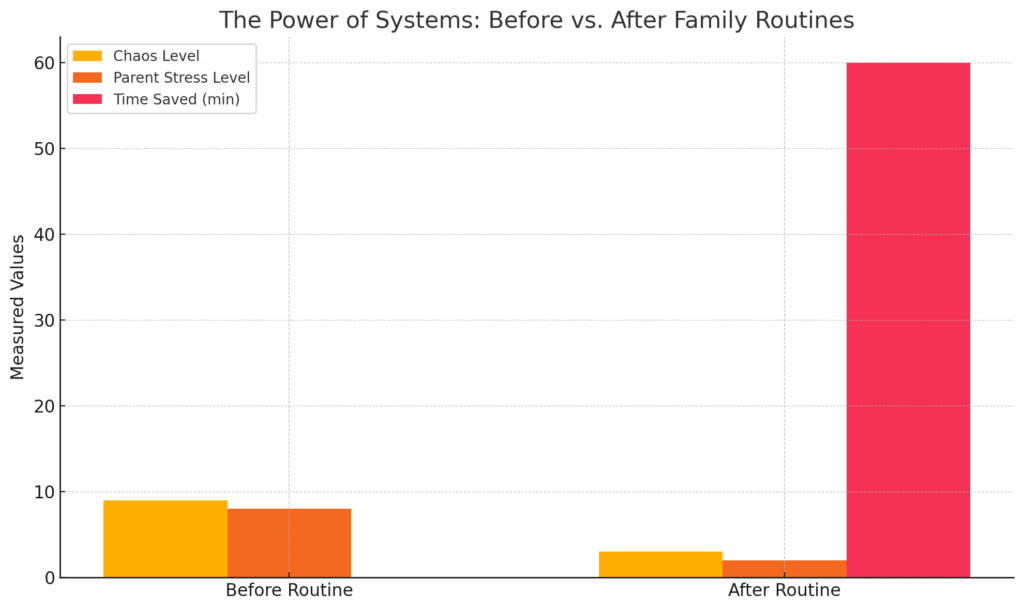
Strategy #2: The Strategic Wake-Up Schedule ⏰
Not all kids are created equal when it comes to morning personalities, and pretending otherwise is a recipe for disaster. Some children bounce out of bed like caffeinated kangaroos, while others need extensive negotiation and possibly a written invitation to join the land of the living.
Instead of treating everyone the same in our family morning routines, we’ve developed a staggered wake-up system:
Early Birds (Kaelyn and Allyson): Up first, they get bathroom time and can help with breakfast prep or younger sibling assistance. These are the kids who genuinely enjoy mornings, which proves that genetic mutations are real.
Middle Ground (Natalie and Melody): Standard wake-up time, follow the established routine, generally cooperative unless someone ate their favorite cereal.
Slow Starters (Gabrielle and Brayden): Extra time built in, gentle wake-up approach, fewer morning responsibilities. These kids need to ease into consciousness like old people getting into hot tubs—slowly and with lots of encouragement.
This approach recognizes that different family organization styles require different strategies. Fighting against your kids’ natural rhythms creates unnecessary stress for everyone and usually results in more tears than a Nicholas Sparks movie marathon.
Sarah’s experience as a middle school math teacher has taught her that kids perform better when their individual needs are recognized rather than ignored. The same principle applies to healthy family routines at home—work with their nature, not against it.
For tips on managing individual personality differences, check out our guide on building healthy family routines.
Strategy #3: The Breakfast Revolution 🍳
Forget Pinterest-perfect breakfast spreads with artfully arranged fruit and homemade everything. When you’re feeding six kids, family meal planning becomes about nutrition, efficiency, and sanity preservation—not Instagram aesthetics.
Our breakfast strategy for family morning routines focuses on three categories:
Grab-and-Go Options: Overnight oats, breakfast muffins made in batches, fruit and granola bars. These get prepared on Sunday for the entire week because Sunday is when we pretend to have our lives together.
Quick Hot Options: Scrambled eggs (made in large batches), frozen waffles, instant oatmeal with toppings. Total prep time: under 10 minutes, which is crucial when you have multiple people having breakfast emergencies simultaneously.
Special Day Treats: Saturday pancakes, Sunday french toast. These happen when we have time to enjoy the process, not when we’re rushing out the door and someone’s crying about syrup distribution fairness.
Research from Harvard’s T.H. Chan School of Public Health shows that regular family meals, even simple ones, contribute to better nutrition and stronger family bonds. But they don’t have to be elaborate to be meaningful—sometimes connection happens over toaster waffles and that’s perfectly fine.
The key to successful morning routine tips is having systems in place so breakfast isn’t a daily decision-making marathon. When everyone knows what the options are and where to find them, mornings flow much smoother. Plus, it reduces the number of times you hear “there’s nothing to eat” while standing in front of a fully stocked pantry.
For more meal planning strategies that work for large families, see our time saving tips for busy parents.
Strategy #4: The Responsibility Matrix 📋
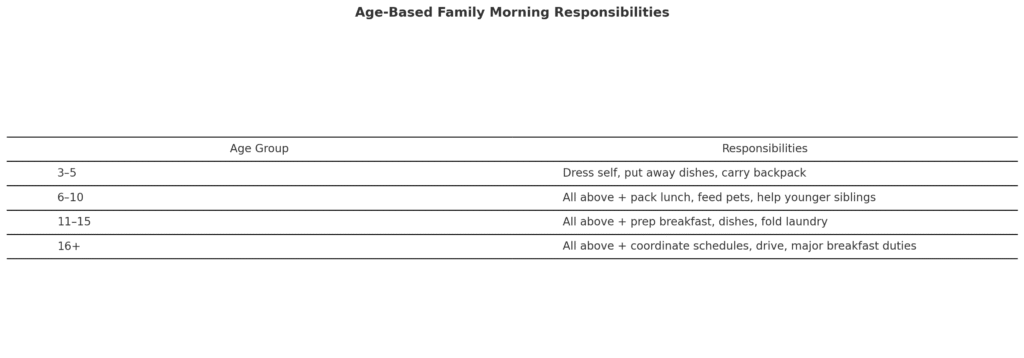
One of the biggest family organization game-changers has been assigning age-appropriate responsibilities to each child. This isn’t about creating child labor—it’s about building capable humans while reducing parental workload and teaching them that families function as teams.
Ages 3-5 (Brayden’s Level): Get dressed (with clothes pre-selected), put dishes in dishwasher after eating, carry own backpack to car. Simple tasks that build confidence and routine habits for family morning routines.
Ages 6-10: Everything above plus pack own lunch (with supervision), feed pets, help younger siblings with simple tasks. This age group loves feeling helpful and important.
Ages 11-15 (Melody and Gabrielle): Previous responsibilities plus help with breakfast prep, load/unload dishwasher, assist with laundry folding. They’re capable of real contributions to healthy family routines.
Ages 16+ (Natalie, Allyson, Kaelyn): Significant breakfast prep responsibilities, help coordinate younger sibling schedules, occasionally drive siblings to activities. Basically, they become assistant parents and surprisingly good at it.
This system teaches practical life skills while making family morning routines more manageable for everyone. The older kids understand they’re contributing to family success, not just being given arbitrary chores to build character (though that’s a nice side effect).
When kids have ownership in the family’s morning success, they’re more invested in making morning routine tips actually work. Plus, teaching these skills now means they’ll be prepared for adult life later—and won’t be those college freshmen who call home asking how to do laundry.
Our guide to exciting chores for kids has more ideas for making responsibilities feel less like work and more like contribution.
Strategy #5: The Communication Command Center 📅
Every successful operation needs a communication hub, and family organization is no exception. In our house, this takes the form of a large wall calendar in the kitchen combined with a daily morning checklist—think mission control, but with more sticky notes and less rocket science.
The calendar includes everything that affects our family morning routines:
- School events and deadlines (because apparently schools assume parents have nothing else to do)
- Sports practices and games
- Medical appointments (so many appointments)
- Family activities and social events
- Special dress requirements (spirit days, PE clothes, pajama day, etc.)
The daily checklist covers the non-negotiables for morning routine tips:
- Personal items (dressed, teeth brushed, hair done to acceptable standards)
- School items (backpack, lunch, homework that definitely exists somewhere)
- Activity items (sports gear, musical instruments, project materials that weren’t mentioned until this morning)
Studies show that well-defined communication systems—like sharing daily plans, using shared calendars, and setting clear morning checklists—can significantly reduce stress in both parents and children. One study from Penn State’s Thrive program highlights how time pressure and lack of routines fuel parental anxiety, while research from BMC Psychology confirms that good parent-child communication builds trust and eases stress.
This visual system means I’m not the only one keeping track of everyone’s schedules—which was getting exhausting and making me feel like a human calendar with anxiety issues. The kids can see what’s coming and prepare accordingly, which makes healthy family routines much more achievable.
Strategy #6: The Emergency Protocol 🚨
Despite our best planning and most organized family morning routines, things still go wrong. Brayden gets sick during breakfast and creates a biohazard situation. Kaelyn realizes her volleyball uniform is still in the wash, soaking wet and definitely not going to be ready in time. Melody can’t find her science project that was “definitely” put in a safe place (translation: could be literally anywhere in the house).
Having family emergency protocols prevents these situations from derailing the entire morning and turning everyone into stress monsters:
Sick Child Protocol: Designated backup caregiver plan, emergency contact list readily available, basic supplies kit in accessible location. Because kids have an uncanny ability to get sick at the most inconvenient times possible.
Missing Item Protocol: Designated search team (usually older siblings), backup options for common items, emergency school supply kit in car. When all else fails, Amazon Prime exists for a reason.
Running Late Protocol: Priority task list (absolute essentials vs. nice-to-haves), communication plan for affected activities, stress management techniques that don’t involve screaming. Focus on what matters most for time saving tips.
The key is staying calm and executing the plan rather than panicking and making everything worse. Trust me, your kids will remember how you handled crisis situations much more than whether their hair was perfectly styled.
For more crisis management strategies, check out our home safety tips from a veteran dad.
Strategy #7: The Connection Point ❤️
Here’s what most morning routine tips miss entirely: the goal isn’t just efficiency—it’s maintaining family connection even during busy times. Because what’s the point of having smooth family morning routines if you lose the heart of why you’re doing this in the first place?
Despite the controlled chaos, we make sure to include small connection moments:
Individual Check-ins: Even if it’s just thirty seconds, I try to have a brief one-on-one moment with each child. Sometimes it’s about their plans for the day, sometimes it’s just a hug, sometimes it’s reassurance that yes, their hair looks fine and no, nobody will notice that tiny stain on their shirt.
Family Blessing/Affirmation: Before everyone scatters to their respective destinations, we take a moment to wish each other well. Nothing fancy or formal required—just acknowledgment that we care about each other’s success and want everyone to have a good day.
Weekly Planning Meeting: Sunday evenings, we review the upcoming week as a family. Everyone gets input on schedule challenges and family priorities. It’s like a board meeting but with more snacks and fewer PowerPoint presentations.
These small rituals remind us that we’re a team working toward common goals, not just individuals competing for bathroom time and breakfast options. They’re what transform family organization from a logistical exercise into something meaningful.
Research from the American Academy of Pediatrics emphasizes that consistent family rituals, even brief ones, contribute to children’s emotional security and family cohesion—which makes everything else easier.
For more ideas on building family connections, read about creating meaningful traditions.
Making Family Morning Routines Work for YOUR Family
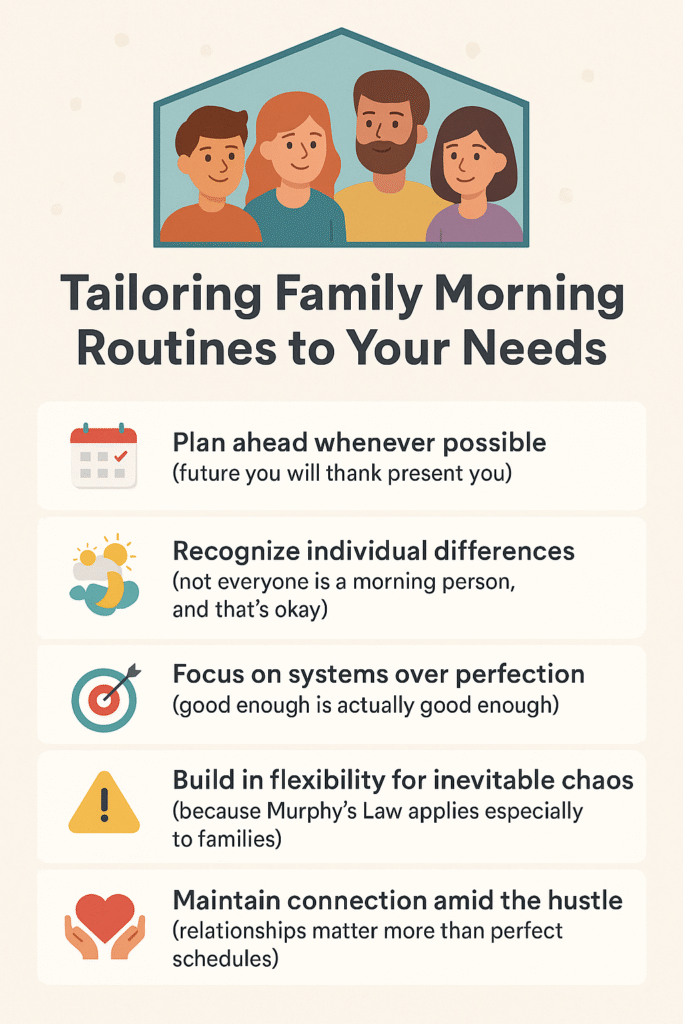
The beautiful truth about family morning routines is that there’s no one-size-fits-all solution. What works for our circus of eight might need significant modification for your family’s unique brand of chaos.
The key principles for effective morning routine tips remain the same:
- Plan ahead whenever possible (future you will thank present you)
- Recognize individual differences (not everyone is a morning person, and that’s okay)
- Focus on systems over perfection (good enough is actually good enough)
- Build in flexibility for inevitable chaos (because Murphy’s Law applies especially to families)
- Maintain connection amid the hustle (relationships matter more than perfect schedules)
Start with one strategy and implement it consistently for two weeks before adding another. Change is hard for kids (and adults), so gradual implementation works better than trying to overhaul everything at once and creating a family revolution.
The Real Goal: Sustainable Family Rhythms 🎵
After years of trial and error, I’ve learned that successful healthy family routines aren’t about having a Pinterest-perfect morning. They’re about creating sustainable rhythms that allow your family to function well together while maintaining everyone’s sanity and sense of humor.
Some mornings still feel like barely controlled chaos. Brayden occasionally still tries to wear his pajama top to school (it’s comfortable, he argues). The older girls sometimes have teenage moments that require patience, humor, and possibly chocolate.
But most mornings now feel manageable thanks to our established family morning routines. The kids know what’s expected, they have the tools to succeed, and Sarah and I can actually drink our coffee while it’s still hot—which might be the real definition of parenting success.
The military taught me that successful operations require good planning, clear communication, and adaptable execution. Turns out, these same principles create family organization magic when applied with love, patience, and realistic expectations.
Your family morning routines don’t need to look like anyone else’s. They just need to work for you, reduce stress, and help everyone start their day feeling prepared and loved.
Because at the end of the day, that’s what really matters—not whether your kids’ hair is perfect or their backpacks are color-coordinated, but whether they know they’re part of a family team that supports each other through both the smooth mornings and the chaotic ones.
And trust me, there will be plenty of both. The chaos just becomes more entertaining when you have systems in place to handle it.
Action Steps for Implementation 🚀
Ready to transform your family morning routines? Start here with these time saving tips:
Week 1: Implement the night-before preparation routine. Focus only on clothes selection and backpack organization. Master these morning routine tips before moving on.
Week 2: Add breakfast planning to your healthy family routines. Prep three grab-and-go options and establish clear breakfast choices.
Week 3: Create your family communication center for better family organization. Set up the calendar and daily checklist system.
Week 4: Assign age-appropriate responsibilities and establish the staggered wake-up schedule that works for your family morning routines.
Remember, sustainable change happens gradually. Give your family time to adjust to each new element before adding the next one—rushing the process usually results in rebellion and tears.
The goal isn’t perfection—it’s progress toward family morning routines that work better for everyone involved. And when that happens, you’ll discover that even chaotic mornings can be filled with connection, laughter, and the satisfaction of a family working well together.
After all, some of our best family memories have come from those imperfect mornings when everything went wrong but we figured it out together. That’s the real magic of family life—not the smooth moments, but the resilience we build navigating the challenging ones as a team.
For more strategies on building strong family systems, explore our family harmony with teenagers guide and discover staying focused tricks that transform your day.
🌐 Explore More from My Family of Blogs
If you found this article helpful, you might also enjoy what I’m sharing across my other platforms. Each one is designed to uplift, equip, and inspire families in real, practical ways:
🏠 Mountains Will Move
Faith-based encouragement for everyday families. I dive into prayer, parenting, purpose, and pressing through life’s hardest seasons with Jesus at the center.
👉 Visit Mountains Will Move »
🔎 Everyday Exposed
My no-filter truth hub—where I tackle myths, challenge misleading narratives, and bring clarity to the conversations that matter most.
👉 Visit Everyday Exposed »
Whether you’re diving deeper into pet care, faith, or uncovering truth in today’s noisy world, I hope you’ll journey with me.
Thank you for being part of the journey. God Bless you and your family. 🙏
